Understanding the Landscape of Children's Oral Health
Pediatric dental health remains a critical public health issue with vast impacts on children’s overall well-being. Despite advances in dental care and preventive strategies, dental diseases such as caries continue to affect a significant portion of children globally and nationally. This article explores the statistical trends, underlying factors, and implications of pediatric oral health problems through comprehensive data drawn from multiple trustworthy sources. We investigate disparities, access to care, historical milestones, and future priorities to present a detailed picture of oral health challenges facing children today.
Current Prevalence and Trends in Pediatric Oral Health
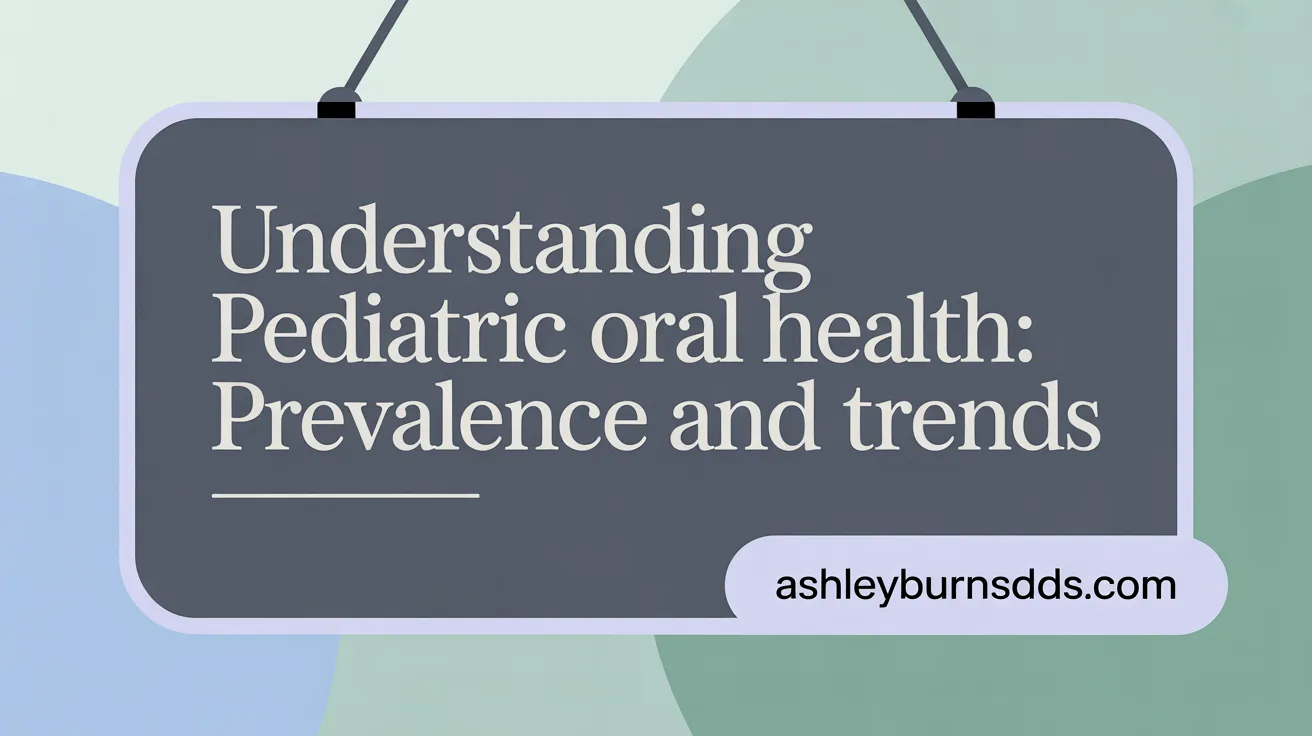
What are the current prevalence rates and statistical trends of pediatric oral health challenges?
Pediatric oral health in the United States continues to face significant challenges, despite ongoing improvements. Recent statistics show that over 20% of children aged 2 to 5 years experienced dental caries in their primary teeth during 2011–2016. For children aged 6 to 8, the prevalence of dental caries was even higher, with more than half (52%) affected.
Untreated dental decay remains a major concern, affecting approximately 13.2% of children aged 5-19 years according to data from 2015–2018. Notably, about 1 in 5 children aged 6–9 years has at least one untreated cavity, highlighting ongoing issues with access to timely dental care.
Over the past two decades, there has been a decline in untreated decay rates among children, especially in low-income groups. For instance, the prevalence of untreated caries decreased from more than 20% to nearly 10% among young children, indicating some progress in prevention efforts.
However, disparities persist across racial, ethnic, and socioeconomic lines. Children from low-income families are twice as likely to suffer from caries and untreated decay compared to their more affluent peers. Minority groups such as Hispanic and Black children experience higher rates of dental disease, with some groups showing caries prevalence exceeding 50%.
Children with special health care needs (SHCN) report worse oral health outcomes and higher unmet dental care needs. Between 2016 and 2022, data reveal that these children experienced more dental problems and barriers to care, worsened further during the COVID-19 pandemic.
The pandemic significantly impacted dental service utilization; there was a noticeable drop in visits for all children in 2020, with children with SHCN experiencing a more pronounced decline (5.7% vs. 4.3% in general). Although some rebound occurred by 2022, access to preventive and routine dental services for children with special needs has not returned to pre-pandemic levels.
Overall, while progress has been made in reducing some aspects of pediatric dental disease, these persistent disparities and high prevalence rates underscore the ongoing need for targeted public health initiatives and improved access to dental care for vulnerable populations.
Major Dental Health Issues in Children: Scope and Severity
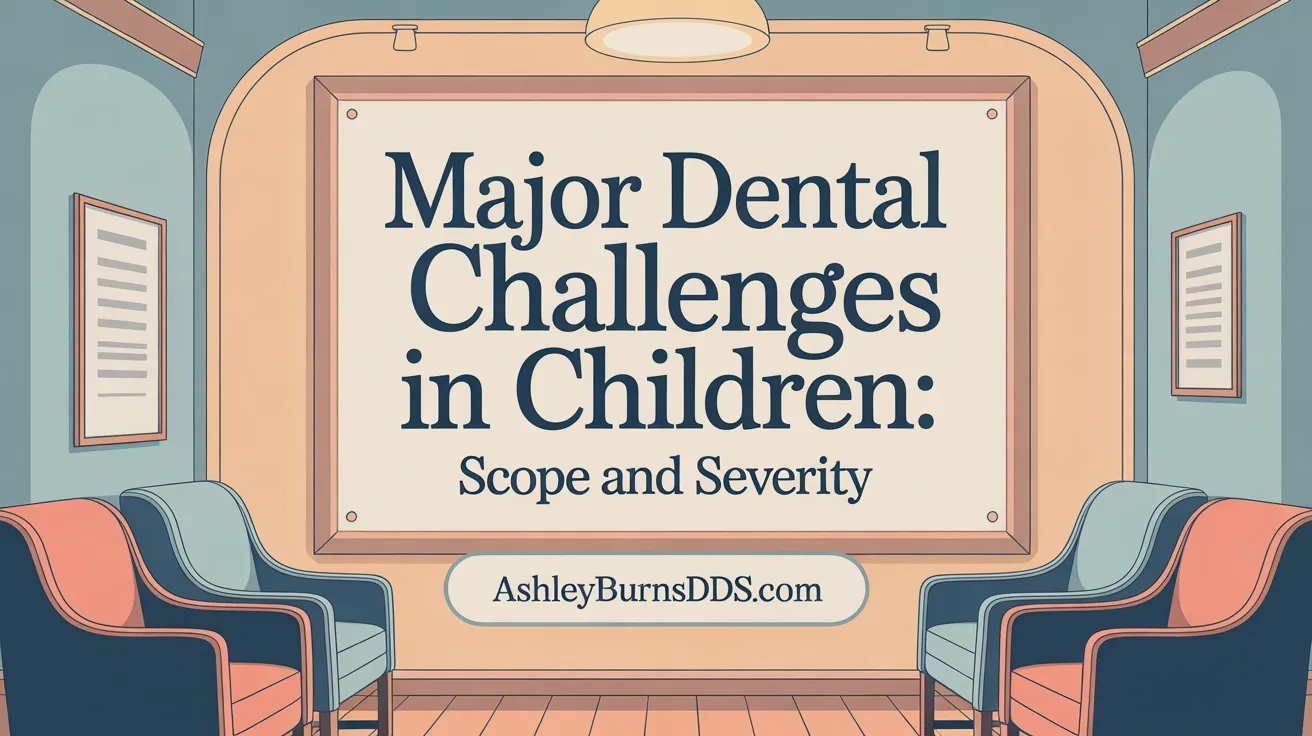
What are the major dental health issues affecting children, and how severe are they?
Children face several oral health challenges, with dental caries (tooth decay) being the most common and widespread. Data shows that over 50% of children aged 6-9 years are affected by dental caries, with younger children, especially those aged 2-5, experiencing a prevalence of about 10-20%. These cavities do not just cause discomfort; if left untreated, they can progress to infections, leading to pain, swelling, and even tooth loss.
Gum diseases, such as bleeding gums and periodontal issues, also affect children, especially adolescents. Dental trauma from accidents or sports injuries can cause fractures or displacement of teeth, impacting oral function and appearance. Developmental defects like fluorosis, caused by excessive fluoride, and erosion from acidic foods or reflux, contribute additional concerns to pediatric oral health.
The severity of these conditions varies. Early lesions are reversible, particularly when detected promptly through regular dental visits. However, untreated caries can develop into deep infections, abscesses, and extensive decay, necessitating extractions or complex restorations. The impact extends beyond physical health — untreated dental issues can impair chewing, speech, and self-esteem, affecting overall well-being.
Children from low-income families and minority groups bear a disproportionate burden of these problems. They’re less likely to have regular dental screenings or access to preventive care, such as fluoride treatments or sealants. Community-based and early intervention programs are vital to bridging these gaps.
Preventive strategies include the application of fluoride varnish, dental sealants, and encouraging early dental visits—ideally by age one. These measures significantly reduce the risk and severity of cavities. Promoting access to dental care and education, especially in vulnerable populations, remains crucial for improving children’s long-term oral health.
Disparities and Patterns in Children's Dental Health
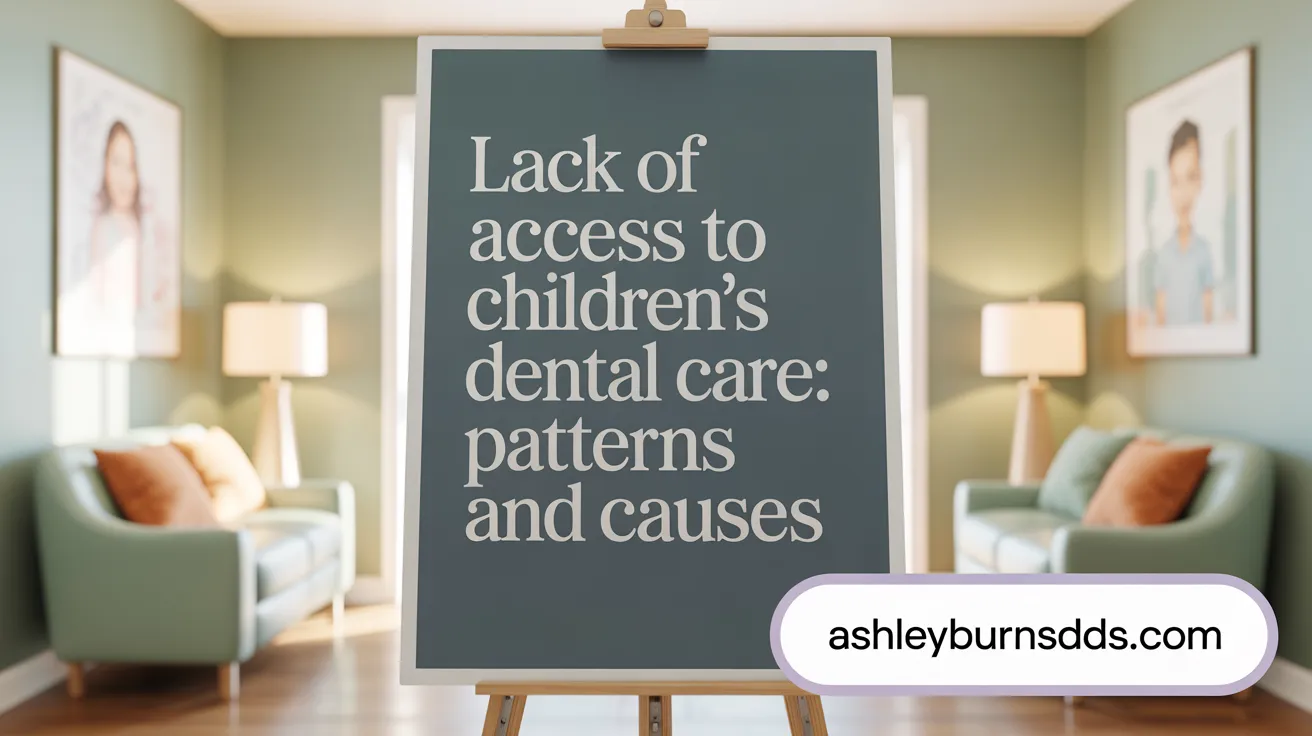
What factors contribute to disparities and patterns observed in children's dental health?
Children's dental health disparities are influenced by a complex mix of social, economic, racial, and environmental factors. Socioeconomic status plays a significant role, as families with lower income levels often face barriers to accessing dental care, preventive services, and healthy foods essential for oral health.
Research shows that children from low-income families are twice as likely to suffer from dental caries and experience untreated decay compared to their more affluent peers. Food insecurity further exacerbates these issues, leading to higher rates of untreated cavities and poor oral health outcomes.
Racial and ethnic disparities are also prominent. Minority groups, including Hispanic, Black, and Indigenous children, tend to have higher prevalence of dental caries and unmet dental needs. These disparities stem partly from historical inequities, cultural factors, and language barriers that limit access to quality dental care.
Systemic barriers significantly contribute to these patterns. Limited insurance coverage, shortages of pediatric dental providers, especially in underserved communities, and fewer community-based prevention programs restrict preventive care that could otherwise reduce decay and improve oral health.
Environmental influences, such as community water fluoridation coverage and neighborhood resources, also impact oral health. Areas with less access to fluoridated water or community health initiatives tend to have higher disease burdens.
In summary, disparities in children's dental health are rooted in social determinants like income, race, and neighborhood conditions. Addressing these involves improving access, expanding preventive services, and reducing systemic inequities that disproportionately affect socially disadvantaged groups.
Impact of Access to Dental Care on Children's Oral Health
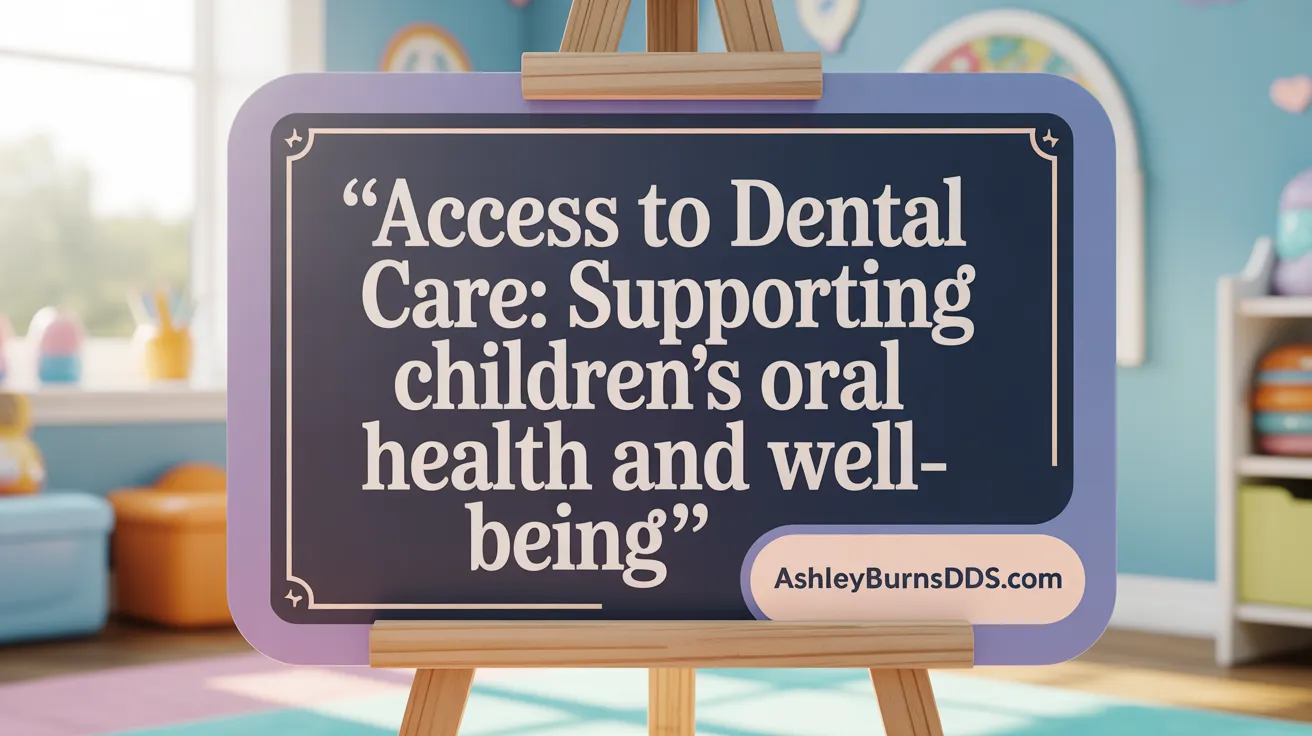
How does access to dental care impact the oral health outcomes of children?
Access to dental care plays a crucial role in shaping the oral health of children. It allows for early diagnosis and treatment of dental conditions like cavities and gum disease, which are prevalent among young populations. When children have regular opportunities to see a dentist, preventive measures such as fluoride treatments and sealants can be administered early, effectively reducing the risk of decay.
School-based programs and community interventions have proven beneficial in increasing dental care accessibility. For example, many programs provide fluoride varnish applications and dental education directly in schools, especially targeting underserved areas. These initiatives help bridge the gap caused by socioeconomic disparities and often lead to a measurable decline in untreated caries.
Children with limited access—often due to financial, geographic, or systemic barriers—tend to experience higher rates of dental problems, pain, and emergency dental visits. This disparity highlights the importance of integrating oral health into primary health services and establishing a dental home for children early in life. Such strategies ensure that children develop lifelong oral health habits and reduce the burden of dental disease.
When access improves, outcomes tend to improve as well. Data shows that communities with expanded dental coverage and outreach see reductions in untreated caries and better overall oral hygiene among children. These improvements not only lessen future dental care costs but also have positive implications for children’s general health, school attendance, and self-esteem.
In summary, facilitating access to dental care for children is essential for preventing dental diseases, promoting healthier behaviors, and reducing health disparities. Ongoing investments in community programs, school-based services, and policy initiatives are vital for ensuring equitable oral health for all children.
Historical Milestones and Advances in Pediatric Dentistry
What historical milestones and research advancements have shaped modern pediatric dental health?
The development of pediatric dentistry into a specialized field has been marked by several significant milestones. In the 1940s, the American Dental Association officially recognized pediatric dentistry as a distinct specialty, establishing a professional foundation for focused research and clinical practices tailored to children.
Early efforts in child dental care were pioneered by practitioners like Minnie Evangeline Jordon, who, in the early 20th century, established some of the first practices dedicated solely to treating children. Her work emphasized the importance of age-specific care and preventive strategies.
Research breakthroughs have profoundly influenced dental practices. Studies on the causes of dental caries led to the adoption of fluoride treatments, sealants, and early intervention protocols. This research not only clarified how decay develops but also introduced effective preventive measures.
Technological innovations have further advanced pediatric dental care. Child-friendly clinics and communication techniques have been developed to reduce fear and promote cooperation. Modern tools such as digital X-rays, laser technology, and minimally invasive procedures have made treatments safer, less traumatic, and more effective.
Policy and clinical guidelines have underscored early oral health care. Reports from organizations like the Surgeon General stress the importance of starting dental visits before age one and integrating oral health into overall child health programs.
Overall, these historical milestones and research innovations have transformed pediatric dentistry. From its roots in early 20th-century efforts to today’s comprehensive, preventive, and technologically advanced practice, the field now plays a crucial role in promoting lifelong oral health from infancy through adolescence.
Causes and Primary Impacts of Dental Health Issues in Children
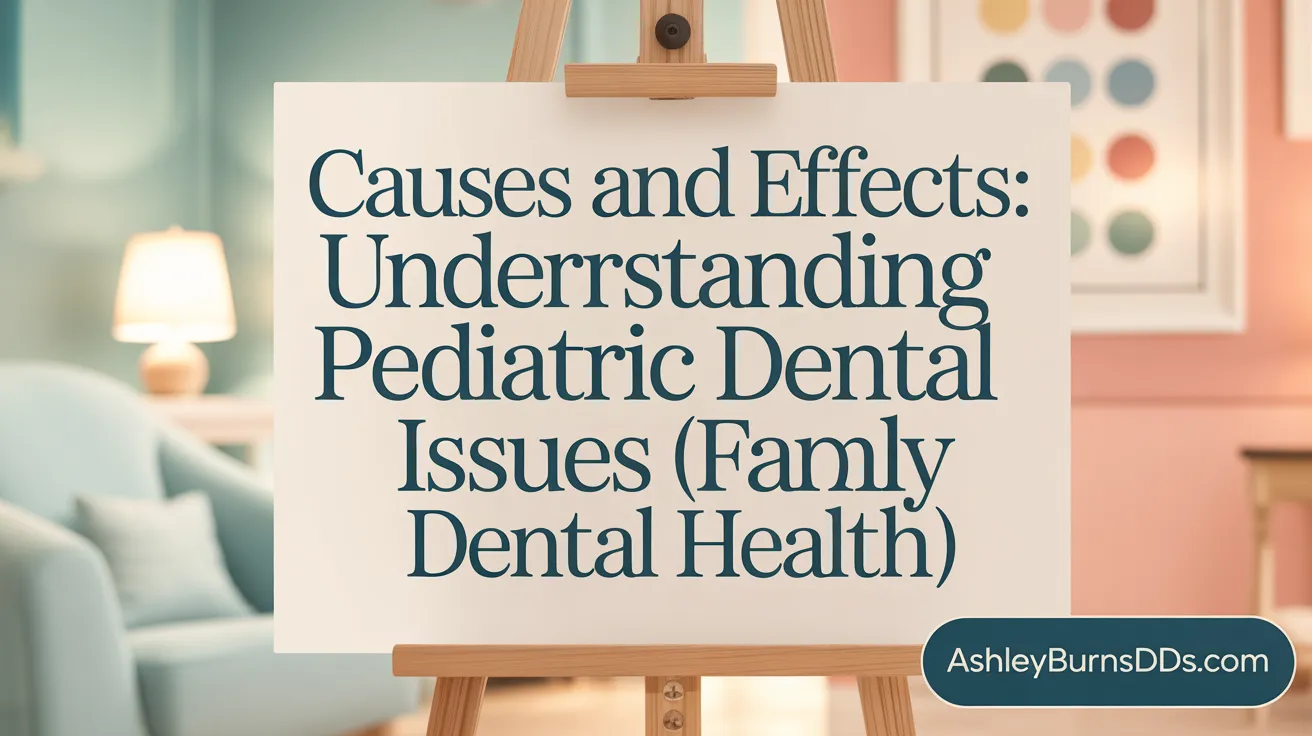
What are the causes and primary impacts of dental health issues in children?
Dental health problems in children mainly stem from a combination of biological, behavioral, and environmental factors. Poor oral hygiene, such as inadequate brushing and flossing, allows plaque to accumulate on teeth, leading to cavities and tooth decay. Dietary habits play a significant role; high sugar consumption from snacks, drinks, and prolonged use of sugary bottles increases the risk for cavities.
In addition, lack of exposure to fluoride—either through community water fluoridation or topical treatments—reduces the teeth’s resistance to decay. Children with infrequent dental visits miss out on early intervention and preventive care, exacerbating dental issues.
Certain behaviors and habits further impact dental health. Prolonged thumb sucking, pacifier use, tongue thrusting, and premature loss of primary teeth can lead to misaligned bites and other dental deformities. Children in low-income or disadvantaged communities often face higher exposure to these risks due to limited access to dental services and educational resources.
The consequences of untreated dental problems are serious. Children experience pain, which can interfere with eating, speaking, and concentration. Dental infections may lead to abscesses and systemic infections if not treated promptly. Dental issues can also cause developmental delays, speech difficulties, and affect a child's self-esteem and social interactions.
On a broader scale, poor oral health in childhood is linked to long-term health problems such as respiratory infections and cardiovascular issues later in life. The impacts extend beyond oral health, affecting nutrition—since painful teeth can hinder proper eating—and psychosocial well-being, shaping self-confidence and social participation.
Preventive strategies are essential. Regular dental checkups, early education on oral hygiene, reducing sugar intake, fluoride application, sealants, and community water fluoridation have proven effective. Ensuring equitable access to dental care and education can significantly reduce the prevalence and impact of dental diseases among children, fostering healthier futures.
Special Challenges in Oral Health for Children with Special Needs
Why do children with special health care needs experience more unmet oral health needs and dental problems?
Children with special health care needs (SHCN) face greater challenges in maintaining good oral health. They are more likely to have untreated dental issues, experience bleeding gums, toothaches, and cavities. This is partly because they often encounter barriers to accessing dental services, and their unique health conditions may complicate regular dental care routines. Studies from 2016 to 2022 reveal that children with SHCN have higher rates of dental problems and unmet needs compared to children without such conditions.
How has the COVID-19 pandemic affected access and oral health among children with SHCN?
The pandemic drastically reduced dental visits for all children, but children with SHCN were hit hardest. Between 2016 and 2022, there was a notable decline in dental visits for children with SHCN, with a decrease of 5.7% compared to 4.3% among children without SHCN. Even as the overall number of visits rebounded for children without special needs, those with SHCN did not return to pre-pandemic levels. This disruption worsened their oral health status, increasing the risk of untreated dental problems and exposing existing disparities.
Why are rates of dental visits not matching the worsening oral health status?
Although children with SHCN have higher rates of dental visits—around 87% have utilized dental services—this did not prevent the deterioration in their oral health during the pandemic. Many factors contribute to this mismatch: the quality and frequency of care, challenges in managing oral hygiene, and access issues exacerbated by the pandemic. This highlights that simply increasing visits is not enough; targeted strategies are needed to improve the quality and effectiveness of dental care for these children.
What socioeconomic and disability factors exacerbate oral health disparities?
Socioeconomic status and disability level significantly influence oral health disparities among children with SHCN. Those living below the poverty line are more likely to have poor oral health outcomes, with an adjusted odds ratio of 2.27 for higher oral health needs. Uninsured children and those with higher levels of disability also face greater barriers to receiving adequate care. Living in certain regions, like the western US, adds to these disparities. Addressing these intertwined factors is crucial to reducing inequities and improving oral health outcomes for vulnerable pediatric populations.
Food Insecurity and Its Link to Dental Caries in Children
How does food insecurity relate to untreated dental caries in children?
Research shows that food insecurity, which involves limited access to nutritious foods, is linked to a higher prevalence of untreated dental cavities among children. A 2021 study published in the Journal of the American Dental Association highlighted that children experiencing food insecurity are more likely to have active caries, primarily because poor diets lacking essential nutrients weaken tooth enamel and promote decay.
How do nutritional deficits contribute to poor oral health?
Inadequate nutrition can diminish a child's ability to fight off infections, including those in the mouth. Deficiencies in vitamin D, calcium, and other minerals crucial for dental health weaken teeth and increase decay risk. Moreover, diets high in sugary, processed foods—common in food-insecure households—provide the perfect environment for cavity-causing bacteria, accelerating decay.
What is the impact on low-income and minority populations?
Children from low-income families and minority groups face a disproportionate burden of dental disease. Data indicates that these groups are twice as likely to suffer from dental caries and untreated decay. Limited access to dental care and nutritional foods exacerbates their vulnerability, leading to more severe oral health issues and higher unmet treatment needs.
Why is integrating social and dental health efforts important?
Addressing food insecurity is essential to improving children's oral health outcomes. Community-based programs that combine nutritional support with dental care awareness, such as school meal initiatives and dental screenings, can help mitigate these disparities. Policymakers and healthcare providers are encouraged to work together to develop integrated strategies that target both social determinants of health and dental prevention, ensuring comprehensive care for vulnerable populations.
Access and Utilization Patterns of Dental Services Among Children
How do dental visit rates vary among different age groups and insurance statuses?
Dental care utilization among children shows notable differences based on age and insurance coverage. In 2015, the annual dental visit rate for children was around 48%. Younger children, especially those aged 2–5 years, had a lower rate of dental visits, with only about 27% of Denti-Cal eligible children receiving dental care in their first two years — a number that remains below ideal levels. As children grow, dental visits increase, reaching nearly 50% for those aged 9–11 years. These rates are heavily influenced by insurance status, with children covered by Medicaid and CHIP showing higher utilization, as nearly 50% of enrolled children used dental services by 2018. Despite improvements, disparities persist, and many children, particularly from low-income families, continue to have limited access to care.
How effective have Medicaid and CHIP been in boosting dental care for children?
Medicaid and CHIP have significantly improved access to dental services for children over the years. From 1993 to 2018, Medicaid dental visits for children surged from 18% to close to 50%, contributing to more children receiving preventive and restorative dental care. These policies aim to reduce barriers for enrollment and coverage, making dental services more accessible for low-income families. However, despite increased coverage, actual utilization still varies due to factors like provider availability and awareness.
What disparities exist in dental service use among young children and foster care populations?
Disparities remain evident among different populations. For example, less than 20% of children aged 1–2 years who are eligible for Denti-Cal have visited a dentist—a stark indicator of underutilization in early childhood. Children in foster care also report higher rates of dental problems and less access to care, with research indicating they face more unmet dental needs. These vulnerable groups often encounter systemic barriers, including dental provider shortages and service gaps, which hinder early preventative care and treatment.
How are community programs helping to increase early preventive care?
Community-based programs like CavityFreeSF have played a vital role in expanding access to preventive services. Initiatives such as fluoride varnish applications during medical visits and public awareness campaigns target reducing early childhood caries. Since 2012, efforts in cities like San Francisco have led to the expanded use of fluoride varnish and increased awareness about oral health. These programs also work toward building a network of providers and educating families, especially in underserved areas, to improve early detection and prevention of dental decay.
| Aspect | Measurement | Impact | Additional Notes |
|---|---|---|---|
| Dental visit rate | 48% (2015) | Overall improvement, yet persistent gaps | Higher among children with insurance |
| Insurance coverage | Nearly 50% of Medicaid/CHIP kids used services (2018) | Increased access, especially for low-income families | |
| Access in early childhood | Less than 20% of 1-2-year-olds visited a dentist | Critical early intervention lacking | |
| Foster care children | Higher dental problems, less access | Targeted support still needed | |
| Community programs | Fluoride varnish programs expanded | Preventive care increased, disparities addressed |
Community Water Fluoridation and Preventive Dental Measures
What is the coverage rate of fluoridation in US public water supplies?
By 2018, community water fluoridation covered approximately 73% of public water systems across the United States. This widespread practice aims to reduce dental decay at a population level, benefiting millions of children and adults.
How effective are fluoride varnish applications and dental sealants in preventing caries?
Fluoride varnish, increasingly used during medical and dental visits, has shown significant benefits, especially in young children. In San Francisco, fluoride varnish application in children increased fivefold from 2014 to 2018. Dental sealants, applied to the chewing surfaces of molars, are highly effective — with about 51% of children aged 9–11 and nearly half of adolescents aged 12–19 having sealants in 2016—contributing to the decline in decay.
What improvements have been made in preventive care since the late 20th century?
Since the 1990s, preventive dental care measures, such as water fluoridation, fluoride varnish programs, and sealant initiatives, have expanded considerably. These efforts have correlated with reductions in untreated caries and overall decay among children, especially in underserved communities.
Are there policy and program initiatives supporting fluoridation and sealant programs?
Yes, federal and local policies support these preventive strategies. Initiatives like the CavityFreeSF program in San Francisco focus on increasing awareness and access, aiming to reduce caries experience through targeted preventive measures. These programs help address disparities and promote oral health equity.
| Preventive Measure | Coverage/Usage Rate | Impact on Caries Reduction | Supporting Policy/Program |
|---|---|---|---|
| Water fluoridation | 73% of public water systems | Decreases caries prevalence broadly | Federal and local fluoridation policies |
| Fluoride varnish | Increased fivefold since 2014 in SF, now widespread | Protects young children from decay | Medical and dental care programs |
| Dental sealants | Nearly 50% of children 9-19 in 2016 | Significantly reduces molar decay | School-based sealant programs and public health policies |
Why are these measures vital for children's oral health?
These preventive tools are proven to be effective, affordable, and safe. They are especially crucial in reducing disparities, protecting vulnerable populations, and fostering lifelong oral health habits.
Range of Oral Health Conditions Beyond Caries in Children

What is the prevalence and impact of gum disease, developmental defects, and dental trauma?
Gum disease, including gingivitis and periodontitis, affects a significant number of children, contributing to pain, bleeding, and eventual tooth loss if untreated. Developmental defects such as enamel hypoplasia and other structural anomalies can compromise oral function and aesthetics, impacting a child's self-esteem and nutrition. Dental trauma, often caused by accidents or sports injuries, results in broken or displaced teeth, requiring urgent attention to prevent further complications and ensure proper development. Overall, these conditions have lasting effects, influencing both physical health and psychosocial well-being.
How do orofacial clefts and craniofacial anomalies affect children?
Orofacial clefts, occurring in approximately 1 in 1000–1500 births globally, involve openings or splits in the lip, palate, or other facial structures. These conditions can interfere with feeding, speech, hearing, and facial development. Craniofacial anomalies may require complex surgical interventions, long-term multidisciplinary care, and support for speech and dental development. If untreated, they can lead to functional impairments and social challenges.
What are the implications of oral infections and disabilities on child health?
Oral infections, such as caries and gum disease, can cause pain, difficulty eating, and increased risk of systemic infections. For children with disabilities, these issues are often exacerbated by challenges in maintaining oral hygiene and accessing care. Children with special health care needs experience higher rates of unmet dental needs, which can lead to deteriorating health, developmental delays, and reduced quality of life.
Why is there a need for comprehensive oral health programs addressing diverse conditions?
A broad approach is essential to address the various oral health challenges faced by children, including caries, gum disease, developmental issues, trauma, and disabilities. Programs that integrate prevention, early intervention, and treatment tailored to the needs of vulnerable groups can reduce disparities and improve lifelong health outcomes. Policies should prioritize access to specialized care, community-based services, and education to ensure all children receive comprehensive oral health support.
| Condition | Prevalence/Impact | Specific Challenges | Recommended Interventions |
|---|---|---|---|
| Dental Caries | Affecting over 50% of children aged 6–11, including untreated cases | Pain, infection, developmental delays | Early prevention, fluoride use, sealants, timely treatment |
| Gum Disease | Affects children with poor oral hygiene and untreated caries | Bleeding, swelling, tooth loss | Oral hygiene education, regular dental check-ups |
| Developmental Defects | Enamel hypoplasia and structural defects common | Increased vulnerability to decay, aesthetics concerns | Protective dental treatments, restorative procedures |
| Dental Trauma | Common in active children and during sports | Tooth fractures, displacement, urgent care needs | Protective gear, prompt dental intervention |
| Orofacial Clefts & Anomalies | Occur in about 0.07–0.15% of births worldwide | Feeding, speech, social integration issues | Surgical repair, multidisciplinary care, speech therapy |
| Oral Infections & Disabilities | Higher prevalence among children with disabilities | Pain, infections, impact on daily function | Specialized accessible care, caregiver training |
This broad spectrum of conditions underscores the importance of targeted, comprehensive programs to improve oral health outcomes and quality of life for all children.
Global Burden of Oral Disease Impacting Children

How widespread are dental caries and untreated decay worldwide?
Globally, dental caries remain the most common health condition, affecting approximately 3.7 billion people. Among these, children are particularly vulnerable, with untreated decay in permanent teeth being prevalent in many regions. For children up to age 12, the prevalence of dental caries can reach as high as 52% in some populations. These conditions cause pain, impair eating habits, and can lead to severe health complications if untreated.
What is the overall burden of oral diseases such as periodontal disease and tooth loss?
Oral diseases pose a significant health burden globally. Over 1 billion cases of severe periodontal disease affect adults, and complete tooth loss (edentulism) impacts roughly 7% of individuals aged 20 and above, increasing to 23% in those over 60. Such conditions compromise nutrition, speech, and quality of life, especially in older populations.
Are there specific pediatric conditions and trauma concerns worldwide?
Children also face unique oral health challenges. Orofacial clefts occur in around 1 in 1000 to 1500 births globally, affected by both genetic and environmental factors. Additionally, around 20% of children up to 12 years experience oro-dental trauma, which can have immediate and long-term effects on development and function. Noma, a devastating infection causing severe facial destruction, affects an estimated 140,000 new cases annually, predominantly in underprivileged regions.
How does WHO prioritize strategies for improving pediatric oral health?
The World Health Organization emphasizes prevention through public health initiatives, promoting integration of oral health into universal health coverage and non-communicable disease strategies. They advocate for community-based approaches, increased access to fluoride, early intervention, and addressing social determinants such as poverty, which significantly influence oral disease prevalence. These strategies aim to reduce disparities and improve oral health outcomes for children worldwide.
| Aspect | Global Impact | Special Focus | Strategies |
|---|---|---|---|
| Dental Caries & Decay | Affects billions, high prevalence in children | Untreated decay affects 17% of youth 2-19 | Prevention campaigns, fluoridation, early dental visits |
| Periodontal Disease | Affects over a billion adults | Chronic oral infections | Oral hygiene, community programs |
| Tooth Loss (Edentulism) | 7% among adults 20+, rising with age | Affects nutrition and quality of life | Prosthodontics, preventive care |
| Pediatric Conditions | Orofacial clefts, trauma, Noma | Significant health and social impact | Surgical repair, trauma prevention, early intervention |
| WHO Strategies | Global public health focus | Integration into health systems | Promotion of preventive policies, access to care, social equity |
This comprehensive approach highlights the global challenge of pediatric oral diseases and underscores the importance of coordinated efforts to improve outcomes for children everywhere.
Impact of Early Dental Visits and Establishing a Dental Home
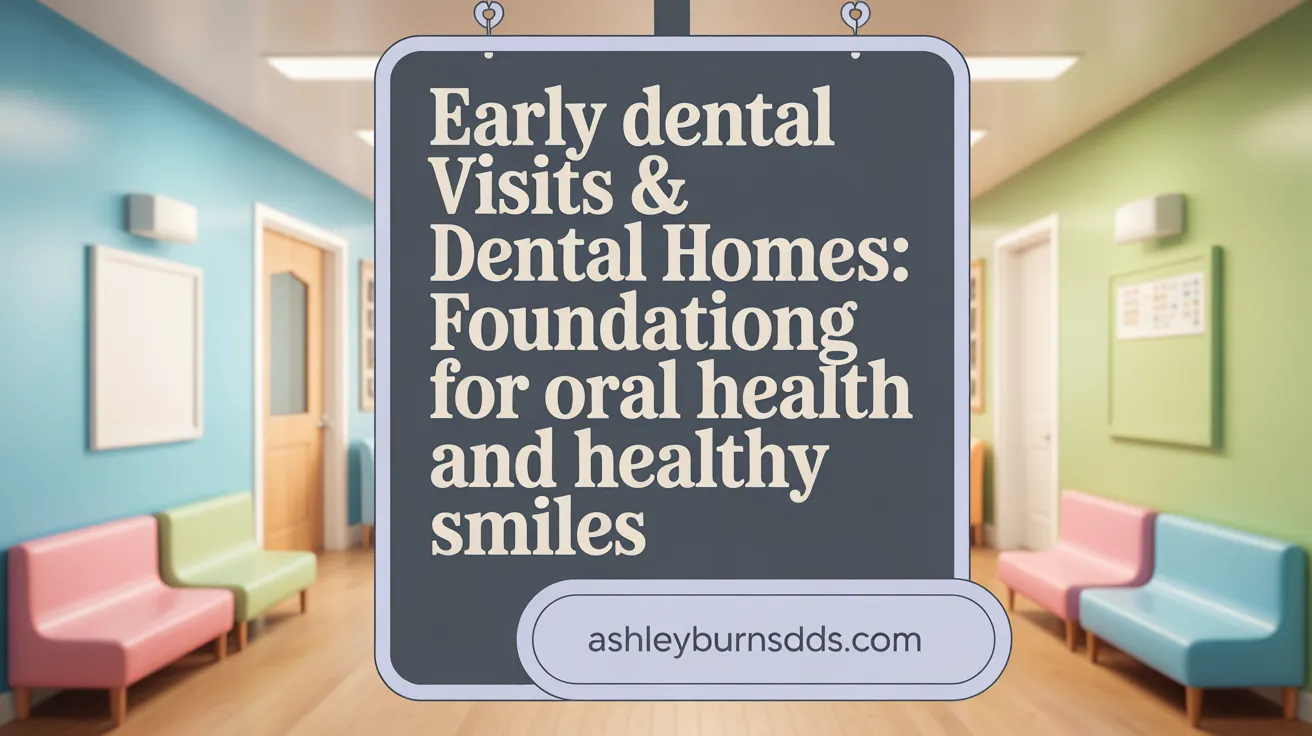
Benefits of early dental care in preventing and reversing decay
Early dental visits are crucial in slowing or reversing the process of tooth decay among children. Initiating dental care by age one allows health professionals to identify early signs of dental problems and implement preventive measures. This proactive approach reduces the likelihood of future cavities, alleviates pain, and promotes overall oral health.
Recommendations for dental visits by age one
The American Academy of Pediatrics and dental health experts recommend that children have their first dental appointment by their first birthday. Early visits provide an opportunity to educate parents about proper oral hygiene, nutrition, and the importance of fluoride use, setting the foundation for lifelong dental health.
Role of dental homes in continuity of care and education
Establishing a dental home—an ongoing relationship with a dental provider—ensures children receive consistent, preventive, and restorative care. Dental homes are essential for ongoing education on good oral hygiene practices, monitoring oral development, and addressing issues promptly. They foster better communication between families and providers, which is especially important for children with special health care needs.
Link to reduced treatment costs and improved quality of life
Getting children into a dental home early helps reduce the need for extensive treatments later. Prevention and early intervention not only decrease treatment costs but also lead to better health outcomes. Maintaining good oral health improves children's ability to eat, speak, learn, and develop normally, enhancing overall quality of life.
Role of Parental Education and Behavioral Factors in Children's Oral Health

How does parental knowledge influence children's oral hygiene and diet?
Parents play a crucial role in establishing healthy oral habits in children. Their understanding of proper brushing techniques, the importance of regular dental visits, and the impact of diet on dental health significantly affect how children care for their teeth. Studies show that children whose parents are well-informed about oral health are more likely to maintain good oral hygiene and avoid decay.
Why is reducing sugar intake and promoting fluoride use important?
Excessive sugar consumption is a leading cause of caries in children. Parental efforts to limit sugary snacks and beverages can dramatically reduce the risk of cavities. Additionally, promoting fluoride use, through fluoridated water and fluoride toothpaste, strengthens tooth enamel and helps prevent decay. Community programs often emphasize these behaviors to improve pediatric oral health.
What behavioral interventions can improve oral health habits in young children?
Interventions such as establishing routine brushing, limiting sugary foods, and regular dental check-ups help establish lifelong habits. Behavioral coaching for parents, along with reminder systems and positive reinforcement, can boost adherence to these health practices. Early preventive visits by age one are especially effective to slow or reverse early decay.
How do community outreach and education programs target families?
Many public health initiatives focus on educating families about oral health, especially in underserved communities. Programs like citywide fluoride varnish applications, outreach at schools, and parent workshops aim to increase awareness and access. These efforts are vital in reducing disparities and encouraging healthy behaviors from a young age.
Disparities in Oral Health by Race and Ethnicity
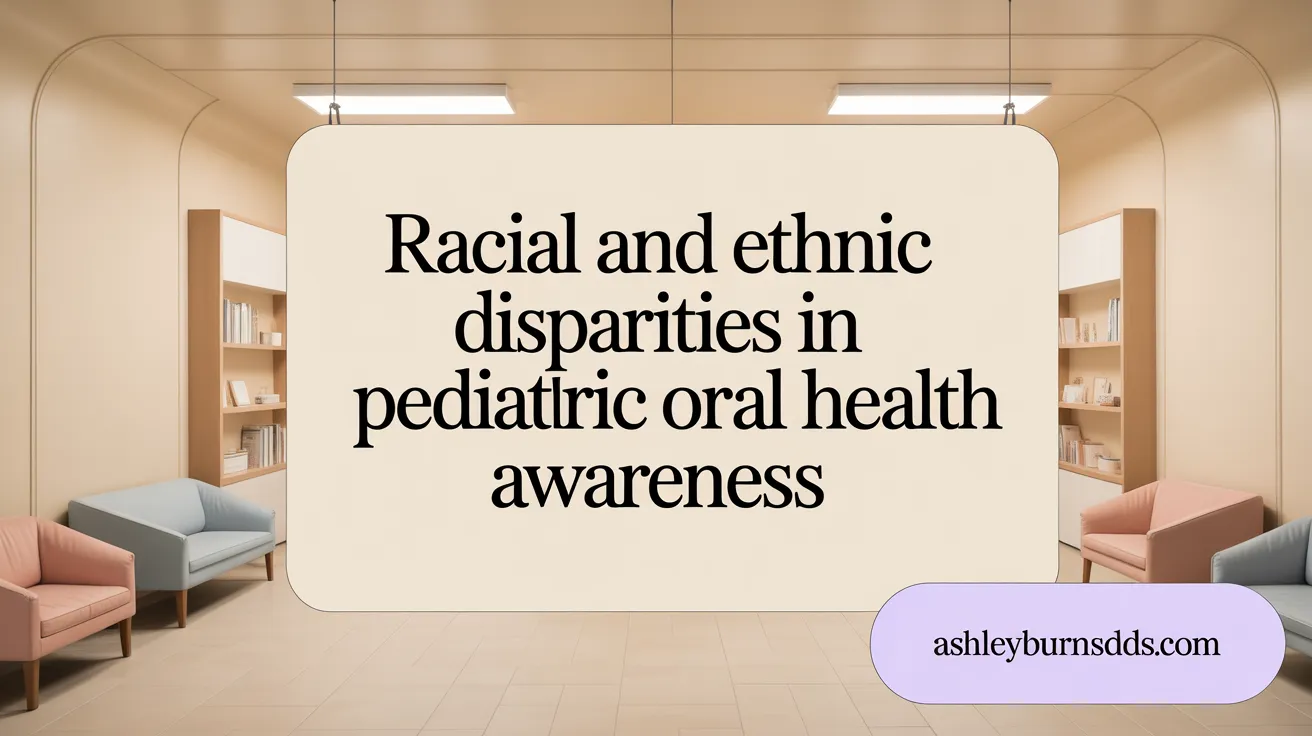
Why do Hispanic, Black, and Indigenous children show higher rates of dental issues?
Research consistently shows that children from Hispanic, Black, and Indigenous backgrounds experience a greater burden of dental caries and untreated decay compared to their white counterparts. For instance, data reveals that the prevalence of total dental caries is highest among Hispanic youth at 52%, followed by Non-Hispanic Black children at 44%, and Asian children at 43%. This disparity results from multiple factors, including limited access to preventive care, lower utilization of dental services, and socioeconomic challenges.
What systemic inequities contribute to barriers in dental care?
Systemic issues deeply influence disparities. Many children in marginalized communities face obstacles such as inadequate healthcare infrastructure, insufficient availability of dental providers, and lack of insurance coverage. For example, despite efforts to expand Medicaid and CHIP dental benefits, utilization remains uneven. Additionally, geographic disparities—especially in underserved urban and rural areas—limit access, further exacerbating oral health inequalities.
How do cultural, social, and economic factors play a role?
Cultural beliefs and social norms also impact oral health behaviors. Families may lack awareness of the importance of early dental visits or preventive practices like fluoride use. Economic constraints are significant; children from low-income families are twice as likely to suffer from tooth decay and have untreated cavities, often due to inability to afford care or transportation issues. These factors create a cycle where disparities persist across generations.
Why is it important to develop culturally aware and targeted programs?
Addressing these disparities requires interventions that are culturally sensitive and tailored to specific community needs. Culturally aware programs can improve health literacy, promote early preventive practices, and remove linguistic barriers. Initiatives like community-based education, mobile clinics, and partnerships with trusted community organizations have shown effectiveness in reducing oral health gaps among minority populations.
| Population Group | Caries Prevalence | Barriers to Care | Suggested Interventions |
|---|---|---|---|
| Hispanic Children | 52% | Language, economic barriers | Culturally tailored education, community clinics |
| Black Children | 44% | Insurance gaps, limited provider access | Outreach programs, fluoride varnish initiatives |
| Indigenous Children | Elevated rates | Systemic neglect, geographic isolation | Mobile dental units, culturally sensitive outreach |
Addressing these disparities holistically is essential to ensure equitable oral health for all children, regardless of their racial or ethnic background.
Effect of the COVID-19 Pandemic on Pediatric Dental Care
Declines in dental visits during 2020 across all children
The COVID-19 pandemic caused a significant drop in dental visits among children, with a notable decrease observed in 2020. Overall, dental care utilization reduced markedly across all pediatric groups. This decline was driven by closures of dental offices, fears of virus transmission, and reductions in routine care.
More pronounced reduction among children with special health needs
Children with special health care needs (SHCN) experienced a sharper decline in dental visits compared to their peers. In 2020, dental visits for children with SHCN dropped by 5.7%, surpassing the 4.3% decrease for children without SHCN. Despite higher baseline utilization, children with SHCN faced greater barriers to maintaining regular dental care during this period.
Impact on oral health outcomes and widening disparities
The pandemic's disruption in access to dental services worsened oral health outcomes, especially among vulnerable populations. Data shows that children with SHCN and those from low-income families experienced a greater increase in untreated dental issues and overall poorer oral health. Disparities in oral health, already persistent, widened during this period, highlighting inequalities linked to race, socioeconomic status, and disability.
Recovery and ongoing access challenges in post-pandemic period
While some rebound in dental visits occurred by 2022, children with SHCN did not return to pre-pandemic levels, indicating ongoing access issues. Continuing challenges include a shortage of pediatric dental providers, especially in underserved areas, and lingering fears and restrictions. Efforts are underway to address these gaps, but ensuring equitable access remains a critical concern for public health stakeholders.
This pattern underscores the importance of resilient healthcare systems and targeted policies to prevent setbacks in pediatric oral health, particularly for high-risk children.
Insurance and Policy Advances Supporting Pediatric Dental Health
How has Medicaid and CHIP expanded dental coverage for children?
Over recent decades, federal and state initiatives have significantly increased dental coverage through Medicaid and the Children's Health Insurance Program (CHIP). By 2018, nearly half of all children enrolled in these programs had utilized dental services, a substantial rise from previous years.
Medicaid's dental benefits for children have broadened, leading to a notable increase in dental visit rates. For example, the annual dental visit rate climbed from 18% in 1993 to nearly 50% in 2018, reflecting successful policy efforts to improve access.
What is the impact of public insurance funding on dental services utilization?
Public funding has played a pivotal role in boosting the utilization of dental care among low-income children. The expansion of Medicaid and CHIP has facilitated access to preventive and routine dental services, resulting in measurable declines in untreated caries, especially in vulnerable groups.
Despite these improvements, utilization remains low among very young children; less than 20% of Denti-Cal eligible children aged 1–2 years receive dental visits. This indicates ongoing barriers to early access.
How do policy statements from dental and pediatric organizations promote early oral health?
Organizations such as the American Academy of Pediatrics have issued policy statements emphasizing early interventions, including fluoride varnish applications and regular dental check-ups starting from age one. These guidelines aim to prevent decay and improve long-term oral health outcomes.
Community-based research and public health initiatives now stress integrating oral health into overall pediatric care, recognizing the importance of early preventive measures.
What challenges remain despite policy and insurance improvements?
While coverage and utilization have increased, disparities persist. Children from low-income families, racial/ethnic minorities, and those with special health care needs continue to face higher rates of untreated decay and less access to comprehensive dental services.
In San Francisco, for instance, underserved zip codes show caries rates exceeding national targets, and there remains a shortage of pediatric dental providers. Additionally, the COVID-19 pandemic temporarily reduced dental visits, particularly impacting children with special health care needs.
Thus, although policy advances have made significant strides, addressing persistent inequalities and ensuring early, continuous dental care for all children remain ongoing challenges. Focused public health strategies are essential to closing these gaps and promoting equitable oral health.
Innovations in Pediatric Dentistry: Techniques and Technologies
Introduction of minimally invasive treatments and silver diamine fluoride
Recent advancements in pediatric dental care have emphasized minimally invasive approaches to reduce discomfort and improve outcomes. Treatments like silver diamine fluoride (SDF) offer a simple, effective way to arrest dental decay in young children, especially in underserved populations where traditional restorative procedures may be less accessible. SDF is applied directly to cavities, stopping decay and preserving tooth structure with minimal pain.
Advances in digital imaging and laser dentistry
Digital imaging, such as cone-beam computed tomography (CBCT), enhances diagnostic accuracy while reducing radiation exposure. Laser dentistry has transformed treatment options by allowing precise removal of decay, gingival procedures, and soft tissue management with less bleeding and faster healing. These technologies are particularly beneficial for children, offering less invasive procedures and reducing dental anxiety.
Development of child-friendly clinic environments and communication approaches
Creating welcoming, non-threatening dental settings is essential for improving children's experiences. Techniques like colorful decor, distraction tools, and friendly communication help ease fear. Training dental professionals in age-appropriate communication fosters trust and encourages early and regular visits, which are crucial for preventing and managing oral health issues.
Potential for emerging tech to address disparities and improve outcomes
Emerging technologies, including tele-dentistry and mobile clinics, hold promise for reaching children in remote or underserved areas. Digital platforms for education and behavior management can empower families to maintain better oral health at home. Together, these innovations are shaping a future where accessible, effective pediatric dental care can reduce disparities and improve lifelong oral health outcomes.
Case Study: Community Based Oral Health Initiatives
How have community-focused programs improved children's oral health?
One notable example is CavityFreeSF, a citywide initiative in San Francisco that aims to increase awareness, access, and early intervention for children's oral health. Since its launch, this program has led to the expansion of fluoride varnish applications during medical visits and improvements in dental outreach, especially among underserved populations.
What role does fluoride varnish and early dental interventions play?
Fluoride varnish is a proven, cost-effective method to prevent dental decay. Since 2014, San Francisco has increased the use of fluoride varnish from just 11.8% of eligible young children to a much higher rate, significantly reducing the prevalence of cavities. Early visits by age one are encouraged to slow or reverse decay, which can markedly improve health outcomes.
How are efforts targeted at reducing caries in vulnerable groups?
The efforts focus heavily on children living in poverty, immigrant communities, and those with special health care needs. Despite progress, disparities remain. For example, Denti-Cal eligible children and communities in South and East San Francisco face higher caries rates exceeding national averages. Targeted outreach and integrated service models aim to close this gap.
Why is collaboration between public health and dental providers crucial?
Success stories like CavityFreeSF show that partnerships between city agencies, healthcare providers, schools, and community organizations are essential. These collaborations enable the pooling of resources, broadening of outreach programs, and implementation of school-based dental screenings and preventive services, creating sustainable improvements.
| Program Aspect | Implementation Approach | Impact | Challenges |
|---|---|---|---|
| Fluoride varnish | Medical and dental provider collaboration | Reduced cavity rates | Reaching the youngest children |
| Early dental visits | Promoting visits by age 1 | Better decay management | Ensuring access in low-income neighborhoods |
| Community outreach | School and community events | Increased awareness and utilization | Overcoming cultural and language barriers |
| Data tracking | Monitoring caries and treatment | Measuring progress | Addressing persistent disparities |
Community-based programs exemplify effective strategies to improve oral health among children, especially in vulnerable communities, by emphasizing prevention, early intervention, and strong partnerships.
The Road Ahead: Priorities for Improving Pediatric Oral Health

What future priorities should be emphasized to improve pediatric oral health outcomes?
Enhancing pediatric oral health requires a multifaceted approach centered on increasing access, early intervention, education, and policy reforms. One of the foremost strategies is expanding access to preventive and treatment services. This can be achieved through innovative programs such as school-based dental clinics, mobile dental units, and teledentistry platforms, which are particularly effective in reaching underserved populations, including low-income families and rural communities.
Early detection plays a vital role in preventing severe dental problems. Establishing a dental home by age one, promoting early orthodontic evaluations, and integrating routine oral health screenings into pediatric primary care can significantly improve long-term outcomes. The use of minimally invasive treatments—like silver diamine fluoride applications, Hall crowns, and laser dentistry—can make care more comfortable and accessible, reduce the need for extensive procedures, and foster positive dental experiences.
Parental knowledge and behavioral changes are essential for curbing risk factors such as high sugar consumption and poor oral hygiene. Educational initiatives promoting healthy habits from a young age, coupled with community outreach programs, can reduce disparities and improve overall oral health literacy.
In addition, policy and training innovations are needed to tackle existing disparities. Updating clinical training to include the latest evidence-based practices and technological advancements ensures future dentists are well-equipped. Implementing supportive policies that incentivize dental care access, improve Medicaid/CHIP coverage, and address socioeconomic barriers will help reduce gaps among different racial, ethnic, and economic groups.
By prioritizing these areas, stakeholders can make meaningful progress towards healthier smiles for all children, reducing the burden of dental disease and enhancing quality of life well into adulthood.
| Strategy | Focus Area | Potential Impact |
|---|---|---|
| Expanding access | School, mobile, and teledentistry services | Reaching underserved populations, reducing disparities |
| Early detection and intervention | Dental homes, routine screenings, minimally invasive tech | Improving long-term outcomes, reducing complex treatments |
| Parental education | Behavioral change programs | Fostering healthy habits, lowering risk factors |
| Policy and clinical training | Evidence-based practices, technological updates | Enhancing care quality, reducing inequalities |
Future advancements in pediatric oral health hinge on strategic investments in these areas, promising a healthier future generation.
Summary and Call to Action for Pediatric Oral Health
The data clearly show that pediatric oral health continues to be a significant challenge with persistent high prevalence of dental caries and untreated decay, despite encouraging downward trends and expanded access to care. Vulnerable populations including children from low-income families, racial and ethnic minorities, and those with special health needs face disproportionate burdens. Historical and research advances have provided effective tools for prevention and treatment, but disparities in access and outcomes remain a critical concern. Moving forward, comprehensive strategies that emphasize early intervention, expanded preventive services, community engagement, and policy reforms are essential to ensure equitable oral health for all children. By combining innovative technologies, targeted education, and inclusive health policies, we can envision a future where every child enjoys optimal oral health and its positive ripple effects on lifelong well-being.
References
- Children's Health Data
- Dental Caries (Tooth Decay) in Children Ages 2 to 11 Years
- 2024 Oral Health Surveillance Report: Selected Findings
- National Trends in Pediatric Dental Needs and Use by ...
- Oral Health of Women and Children: Progress, Challenges ...
- Children's Oral Health - San Francisco
- State of Little Teeth
- Oral health needs of U.S. children with developmental disorders
- Oral health
- FastStats - Oral and Dental Health
